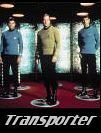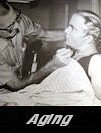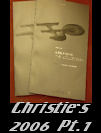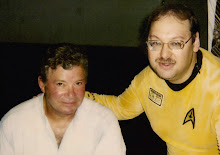This site is honored to present the following article written by the legendary Star Trek Original Series Director Ralph Senensky; whose exceptional work on 7 different TOS episodes includes some of the most memorable and highly regarded shows in the history of the series, encompassing titles such as "This Side of Paradise", "Metamorphosis", "Obsession", "Return to Tomorrow" and "The Tholian Web". Special thanks to Mr. Senensky for his thoughts on the third and final "Season Three" volume in Marc Cushman's Saturn Award winning book series, "These Are The Voyages: TOS", which has just been publicly released for sale and is only available direct from the publisher at http://www.thesearethevoyagesbooks.com/ until February 1, 2015, at which time it will then go into wider release. Fans are encouraged to visit Ralph Senensky's impressive website Ralph's Cinema Trek - A Journey In Film at http://senensky.com/
And now ...
STAR TREK’s second season was turbulent. There was easily as much drama going on behind the scenes as what was being performed before the cameras.
Now as I post about THESE ARE THE VOYAGES – Season Three, I write:
STAR TREK’s third season was cataclysmic. There was definitely more drama going on behind the scenes than what was being performed before the cameras. I should know. I was embroiled in one of those storms.
In 1968 I was fired mid-production of THE THOLIAN WEB. As I reported on my post for THE THOLIAN WEB:
When I reported at 7:30 that Monday morning (the first day), the set (the bridge of the Defiant) was ready, the crew was assembled, I was prepared. But there were no actors. The four of them were in wardrobe, having their final fittings for their silver space-suits. I was told they had been at the studio the day before (Sunday) for their FIRST fittings. As of the end of the day on Friday, since construction of the wardrobe for the first sequence Monday morning had not even begun, a change in the schedule should have been made; but nothing had been done by the production department to adjust for this predicament. … Finally Bill Shatner’s suit was completed, so I filmed some isolated close-ups of Captain Kirk. There weren’t many, and it meant filming the close-ups before we had staged and rehearsed the scenes in which they occurred. Just before noon the other three skin-tight silver space-suits were ready, and we could begin. (At the end of the day I was a half day behind) … (At the end of the third day of filming) I was asked to come to producer Fred Freiberger’s office at the completion of the day’s shooting. There he informed me I was being removed from the project. Because I was still a half a day behind, I was being replaced by what he called a “fireman”, someone who could come in and just get it in the can.
The following day news of my firing was heralded in the pages of Daily Variety and The Hollywood Reporter. What I didn’t know at the time was that there were even more violent storms involving other STAR TREK personnel swirling around. That’s what I’m learning now from Marc Cushman’s brilliant third and final THESE ARE THE VOYAGES.
I find the similarity between the events of that third season and THE THOLIAN WEB to be stunning. Captain Kirk Roddenberry, commanding his starship STAR TREK through the uncharted outer space perils of network television, lost his first officer Mr. Spock Gene Coon, who had left the season before, driven away by the change in command after the purchase of Desilu by Paramount. Plagued by the same changes being made because of the sale of the studio, Captain Roddenberry was more than dismayed when the network reneged on its promise to move the series from its Friday night 8:30 spot to Monday at 7:30, and instead moved it to the deadliest spot possible, Friday night at 10. His response? He would not be a hands-on producer with the show in that graveyard spot. Just as in THE THOLIAN WEB when Captain Kirk was lost in space while being transported back to the Enterprise, Captain Roddenberry was going to be absent from his ship, STAR TREK.
Bones Robert Justman, in a way the doctor for the series, the engine that drove the production side of the show, one who was ready, able and eager to move into the producer seat vacated by the departing Coon, found himself rejected by the network and the studio. He continued to serve the inexperienced sci-fi outsider who was brought in to occupy the coveted seat.
Female Communications Uhura Dorothy Fontana, who had been with STAR TREK since its inception, when she was Roddenberry’s secretary and in its first season rose to the position of story editor and very productive contributor of superior teleplays, now found herself in a position where her communications regarding scripts to the new inexperienced producer were not always heeded. The fact that this was happening in spite of the fact that she knew more about STAR TREK scripts than anyone connected to the show (barring Captain Roddenberry) was not only counterproductive, it was insulting.
And finally just as the Tholians created a web to capture and destroy the Starship Enterprise, the studio and the network created a web to destroy STAR TREK. The studio (Paramount) was not happy with the films costing more to produce than what the network was paying. Executive in charge of production Douglas Cramer had a scorched earth policy. If a director could not complete a film in the mandated six days, he was put on the Do Not Hire list. Joining me on that list were two other experienced STAR TREK directors: Vincent McEveety, who had directed six productions, and John Meredyth Lucas, who had written scripts, directed and served as producer for the series. The network (NBC) was even more diabolical. Twice they had cancelled the series — at the end of Season One and again at the end of Season Two, only to restore it to the schedule because of overwhelming response from outraged STAR TREK fans. This time at the end of Season Three, without announcing whether or not the series would return in the fall, the network announced STAR TREK would return in twelve weeks for a series of summer reruns. When the reruns ended, so did STAR TREK, its original five-year mission cut off after three years.
At the wrap party at the conclusion of photography on TURNABOUT INTRUDER, the 24th episode of the third season and the 79th and final episode of STAR TREK: The Original Series, James Doohan (Scotty) couldn’t believe that a show this good with such a vocal fan base could be canceled. He insisted they would be back. Walter Koenig (Chekov) commented, “… and of course he was right. It just took ten years longer than he thought.”
That is just a small part of the amazing drama that Marc Cushman brings to life so vividly in this final volume of his series. The amazing thing is that he does it as he microscopically presents the detailed evolution of each of the 24 productions filmed that season — from the author’s pitch through story development to final script, into pre-production, production, post production, airing and reaction, the mailbag and memories. I am in awe of the enormity of the project, profoundly moved as I was by the previous two volumes and very grateful that he did it.




























































































